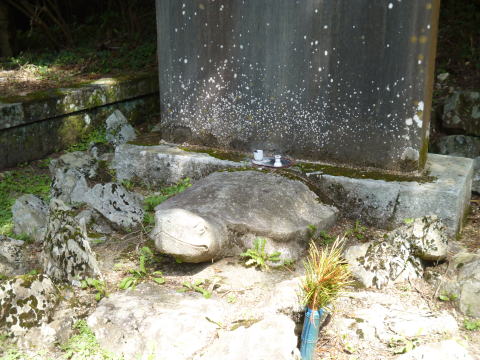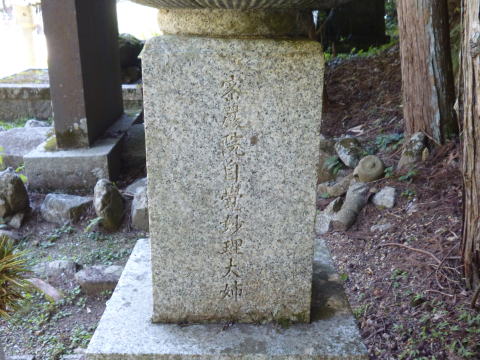Keikyo Monument ![]()
Keikyo Monument is a stone monument located in Okunoin, Koyasan, Wakayama
Prefecture.
This stone monument was created in 1911 as
a replica of the Great Qin Jingkyo Fashionable Chinese Monument, which is owned
by the Beilin Museum in Xi'an, China, and was faithfully reproduced by British
religious scholar Mrs. Elizabeth Anna Gordon. It was erected.
It is a black limestone stone monument 3.6m
high and 1.5m wide, built on the base of a turtle-shaped monument.
Mrs. Gordon was a researcher of
``Buddhism's unity,'' which states that Buddhism and Christianity are
fundamentally the same, and is said to have erected the Keikyo Monument at
Koyasan Okunoin to embody the Buddha's unity.
Next to the Keikyo monument is the
tombstone of Mrs. Gordon, who died in Kyoto in 1925.
It was buried in her inner temple according
to her will, and the front is engraved with ``Grave of Mrs. EA Gordon,'' and
the side is engraved with ``Mitsugon-in Jikaku Myori Dai-nee.''
The Great Qin Jingshu Popular China
Monument, erected in 781 at the Great Qin Temple in Chang'an, Tang Dynasty, is
a monument that records the situation in which Nestorian Christianity became
popular in China during the Tang Dynasty, and is a valuable monument regarding
the transmission of Christianity to the East. It is known as a material.
To the east of Mrs. Gordon's tombstone is
the Kenin-shi Tower (Kenin-Hoshi Memorial Tower).
Take the bus from Koyasan Station on the
Nankai Koya Line and get off at Okunoin Exit, then walk 10 minutes. There is a
free parking lot for worshipers along National Route 371.
Elizabeth Anna Gordon (1851 – 1925)
Although there may be many people who do
not know the name Elizabeth Anna Gordon, I believe that many people have
benefited from the more than 100,000 Japanese-English libraries housed in the
Hibiya Library (Dulce Cor Library). Mrs. Gordon was the person who devoted
herself to the creation of this library.
E.A. Gordon was born in Lancashire, England
in 1851. She later married John Edward Gordon, a Scottish nobleman, both of
whom were from families known for their prestigious ancestry. Mrs. Gordon
served as Queen Victoria's court lady, and later enrolled at Oxford University,
where she studied comparative religion. One of her classmates was Junjiro
Takakusu, an exchange student from Japan, and it is thought that their
friendship became the catalyst for her later linking her husband to Japan.
She became interested in Asian religious studies while she was a student,
and in 1891 (Meiji 24), she stopped by Japan on a world trip with her husband.
During this stay, she became fascinated with Japan's nature, culture, and
national character, and soon after returning to Japan, she joined the newly
founded Japan Society, and began offering assistance to Japanese people
living in the UK. She came to be known as the ``Mother of Japan in Britain.''
Later, after hearing Junjiro Takakusu and others' laments about the lack
of foreign books in Japan, she published an article in British, American,
and Canadian newspapers saying, ``In order to convey British culture to
Japan and at the same time promote goodwill between Japan, Let's give foreign
books to people,'' she called for book donations. Coinciding with the period
when interest in Japan was intensified due to the Russo-Japanese War, close
to 100,000 books were immediately delivered to her. She returned to Japan
in 1907 (Meiji 40) with the book, and through Takakusu, she entrusted all
of the books to the city of Tokyo on the condition that they be released
to the public. In response to her generosity, the city of Tokyo immediately
agreed to pay 5,375 yen and 75 sen to cover the costs of sorting things
out.
Taking this opportunity, she stayed in Japan, and she began researching
the theme of ``Buddhism's unity.'' It was an attempt to demonstrate that
Buddhism and Christianity had one origin, the same root. As part of her
research, she erected a replica of the Great Qin Jingshu Fashionable Chinese
Monument, which was erected in Chang'an in the Tang Dynasty, on Mt. Koya
around the 8th century. The results of her research were contributed to
newspapers and magazines, and several books were published, and in 1925
(Taisho 14) she taught at Waseda university as an honorary lecturer, writing
``On Comparative Religion'' and ``Saiyuki(Journey to the West).'' .
Mrs. Gordon deeply respected Marquis Okuma. The Marquis established Waseda
university in his residence, advocating academic independence and freedom,
and opened its doors widely to accept foreign students from Korea, China,
India, etc., regardless of their nationality, and in 1885 (Meiji 38) This
is probably because his ``devotion to others without expecting anything
in return,'' such as the establishment of the Qing Dynasty Exchange Department
in 2007, strongly resonated with his own feelings of generously providing
aid to people living in Britain. At the beginning of his book ``World-healers,''
or The Lotus Gospel and its Bodhisattvas (published in 1913), she writes
about this and dedicates it to Marquis Okuma.
Mrs. Gordon, who is busy with her research, suddenly receives the sad news that her eldest son, who was serving in World War I, has been killed in action. When her wife hurriedly returned to Japan, she sent her research materials, approximately 1,500 books, and approximately 500 Buddhist paintings and utensils that she had collected in Japan to Waseda University in order to contribute to the research of her colleagues. Donated. Out of respect for Marquis Okuma, the university decided to commemorate it as the ``Gordon Bunko.''
What happened to her after returning to Japan is unknown, but it is known
that she returned to Japan in 1920 (Taisho 9), stayed at the Kyoto Hotel,
and spent her days doing research, and during that time she also wrote
a book. Several volumes have been published. By the time she arrived in
Japan, her husband had already passed away, and her health was so weak
that she did not go out even a single day during her six-year stay. On
June 27, 1925, her kidney disease worsened and she passed away in a room
at a Kyoto hotel. She was 74 years old.
Her funeral was held in Buddhist style at Toji Temple in Kyoto, and her
tomb is located on Mt. Koya, next to the Keikyo Monument.





